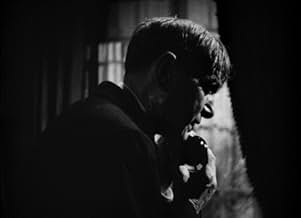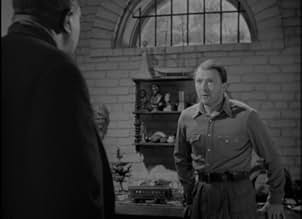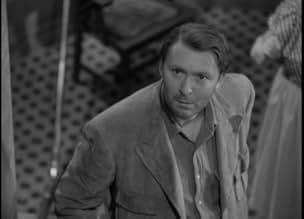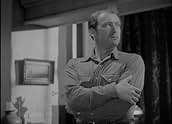A mentally unstable man who has been kept in isolation for years escapes and causes trouble for his identical twin brother.A mentally unstable man who has been kept in isolation for years escapes and causes trouble for his identical twin brother.A mentally unstable man who has been kept in isolation for years escapes and causes trouble for his identical twin brother.
Jane Allen
- Jitterbug Dancer
- (uncredited)
Rod Cameron
- Eddie - Man in Cafe
- (uncredited)
Eddy Chandler
- Motorcycle Cop
- (uncredited)
Lane Chandler
- Neighbor
- (uncredited)
Catherine Craig
- Second Mill Girl
- (uncredited)
Featured reviews
The plot to "Among the Living" is silly and impossible to believe. However, it does appear to be the inspiration for an episode of "The Simpsons"--the one where Bart discovers that he has an identical 'evil' twin who's been locked in the attic for many years! Homer and Marge feed Hugo fish heads and have kept his existence a secret for years! Who would have thought a film would have dared have such a bizarro plot?!
When the film begins, the family patriarch dies and his son John (Albert Dekker) arrives for the funeral. Little does John know that his identical brother, Paul (also Dekker), is STILL alive and did not die as a small child. The family doctor (Harry Carey) divulges the family secret to John...Paul is still alive and insane and has been kept hidden in a secret room in the family mansion! Coincidentally, at this same time, Paul kills his keeper and escapes! Now two identical looking guys are running about town...and one is on occasion unpredictable and homicidal. So it's up to the Doctor and John to try to find Paul...however the heartless Doctor soon tries to stop John from contacting the police by threatening to destroy him! However, Paul is not intend with only killing his keeper...and the bodies start piling up in town. And, soon John is assumed to be the crazed killer by mistake!
As I mentioned above, the plot for this one is just insane...so you really have to suspend disbelief in order to watch this one. Despite this, I did enjoy Dekker's performance as he played both characters, particularly Paul, quite well. Goofy and still very watchable.
When the film begins, the family patriarch dies and his son John (Albert Dekker) arrives for the funeral. Little does John know that his identical brother, Paul (also Dekker), is STILL alive and did not die as a small child. The family doctor (Harry Carey) divulges the family secret to John...Paul is still alive and insane and has been kept hidden in a secret room in the family mansion! Coincidentally, at this same time, Paul kills his keeper and escapes! Now two identical looking guys are running about town...and one is on occasion unpredictable and homicidal. So it's up to the Doctor and John to try to find Paul...however the heartless Doctor soon tries to stop John from contacting the police by threatening to destroy him! However, Paul is not intend with only killing his keeper...and the bodies start piling up in town. And, soon John is assumed to be the crazed killer by mistake!
As I mentioned above, the plot for this one is just insane...so you really have to suspend disbelief in order to watch this one. Despite this, I did enjoy Dekker's performance as he played both characters, particularly Paul, quite well. Goofy and still very watchable.
Sharp, tightly paced low budget film is hard to categorize. There are definitely noirish tendencies but it's not a full blown film noir, there are also elements of horror contained within but neither is a horror movie. Even as a hybrid of different genres it is very involving and uses it short running time to full effect, actually so effective that it received quite a lot of critical attention in its day for a lower budget release and helped move its leading lady's career forward.
Speaking of the leading lady the film is also a study of two stars in flight. Susan Hayward whose full fledged stardom was still a few years away was still definitely on her way up, Frances Farmer, whose part is small, was most definitely on the descent. At one time considered an actress with the brightest of futures this was her second to last picture before descending into a decades long hell of mental illness and involuntary confinement.
The real standout though is Albert Dekker in a dual role of very different twin brothers. An excellent character actor who met a grisly end he rarely had the opportunity of the leading role but he takes his chance here and makes the most of it. His body language and vocal inflections makes the two characters recognizably different men and their struggles relatable. Not readily available and hard to find its definitely worth the effort to seek out.
Speaking of the leading lady the film is also a study of two stars in flight. Susan Hayward whose full fledged stardom was still a few years away was still definitely on her way up, Frances Farmer, whose part is small, was most definitely on the descent. At one time considered an actress with the brightest of futures this was her second to last picture before descending into a decades long hell of mental illness and involuntary confinement.
The real standout though is Albert Dekker in a dual role of very different twin brothers. An excellent character actor who met a grisly end he rarely had the opportunity of the leading role but he takes his chance here and makes the most of it. His body language and vocal inflections makes the two characters recognizably different men and their struggles relatable. Not readily available and hard to find its definitely worth the effort to seek out.
'Among the Living (1941)' sits in the middle-ground between film noir and horror. The horror elements are obvious: the use of twins, representing the duality of man, recalls a more literal take on the themes of Stevenson's "Dr Jekyll and Mr Hyde." But even the "evil" twin himself is not a monster, as he is often described. Like Frankenstein's Creature, he is merely a social outcast, corrupted by the abuse of the true monsters, and who ultimately finds it impossible to assimilate into society. Like a frightened animal, Paul Raden struggles to understand the violent, cynical world in which he's been thrust, and the injustices knowingly done to him, combined with the years of abuse he endured at the hands of a dominating father, lead him to murder out of sheer terror. In many ways, Paul resembles the character of Lennie in Steinbeck's "Of Mice and Men," a simpleton with a brutish strength that he can't reconcile with his own child-like desires.
Though one would stop short of calling this a film noir, there are certainly traces of the necessary elements. Most prominent is the theme of hidden family secrets, of a shameful past coming back to haunt wrongdoers, as in 'The Strange Love of Martha Ivers (1946).' The corruptive influence of power is also referenced – as in the latter film, the primary sinner of 'Among the Living' (Raden, Sr., who is dead by the film's beginning) resides in a town that bears his name. The viewer can draw two conclusions: either that only through committing sin can a man attain power, or that from power itself is borne the desire to perpetrate crime, for he now has the means to conceal his misconduct. The latter is certainly true for the otherwise-respectable Dr. Saunders (Harry Carey), who – just once – compromised his professional integrity, and, twenty-five years later, finds that this one transgression has blackened his soul and destroyed his future.
John Raden (Albert Dekker) is the film's hapless protagonist, an honest guy who unwillingly stumbles upon his family's dirty secret. Via a succession of ill-fated coincidences, implying the forces of Fate that would later pervade the film noir movement, John finds himself on trial for murder, thrust protestingly into an ad hoc mob trial that recalls Peter Lorre's judgement in 'M (1931).' Dekker is excellent in the dual- roles of John and Paul Raden, with the "bad" half always distinguishable, not just by his grizzled beard and raggedy clothing, but by the way he carries himself: slouched shoulders, arms held awkwardly, innocent and perplexed eyes upturned at the eccentricities of this unfamiliar society. Susan Hayward plays Millie, a minor femme fatale. She's an angel when you first see her, but the way she knowingly toys with Paul's naivete is quite repulsive, and her nastiness during the courtroom trial is similarly brutal. Notably, director Stuart Heisler would progress onto full-blown noir the following year with the Hammett adaptation 'The Glass Key (1942).'
Though one would stop short of calling this a film noir, there are certainly traces of the necessary elements. Most prominent is the theme of hidden family secrets, of a shameful past coming back to haunt wrongdoers, as in 'The Strange Love of Martha Ivers (1946).' The corruptive influence of power is also referenced – as in the latter film, the primary sinner of 'Among the Living' (Raden, Sr., who is dead by the film's beginning) resides in a town that bears his name. The viewer can draw two conclusions: either that only through committing sin can a man attain power, or that from power itself is borne the desire to perpetrate crime, for he now has the means to conceal his misconduct. The latter is certainly true for the otherwise-respectable Dr. Saunders (Harry Carey), who – just once – compromised his professional integrity, and, twenty-five years later, finds that this one transgression has blackened his soul and destroyed his future.
John Raden (Albert Dekker) is the film's hapless protagonist, an honest guy who unwillingly stumbles upon his family's dirty secret. Via a succession of ill-fated coincidences, implying the forces of Fate that would later pervade the film noir movement, John finds himself on trial for murder, thrust protestingly into an ad hoc mob trial that recalls Peter Lorre's judgement in 'M (1931).' Dekker is excellent in the dual- roles of John and Paul Raden, with the "bad" half always distinguishable, not just by his grizzled beard and raggedy clothing, but by the way he carries himself: slouched shoulders, arms held awkwardly, innocent and perplexed eyes upturned at the eccentricities of this unfamiliar society. Susan Hayward plays Millie, a minor femme fatale. She's an angel when you first see her, but the way she knowingly toys with Paul's naivete is quite repulsive, and her nastiness during the courtroom trial is similarly brutal. Notably, director Stuart Heisler would progress onto full-blown noir the following year with the Hammett adaptation 'The Glass Key (1942).'
I’d always been interested in this one – not least because it involves twins (and, thus, reminiscent of the Boris Karloff vehicle THE BLACK ROOM [1935]) – so that when I came across the film, even if I knew that the quality would be far from optimal, I leapt at the chance to acquire it. While not strictly horror, it involves several elements that are part and parcel of the genre – old dark house, family secret, madness, murder, mob fury, etc.
Despite, as I said, the fact that the video was rather fuzzy – so that the images generally lacked detail – I was nonetheless struck by the film’s cinematography and editing: these were particularly effective during a scene at a bar, where the mad brother (who had been secluded all his life but has now broken loose) is ridiculed by the customers, and the one following it where he chases a girl into an alley and kills her. The two central roles are played by Albert Dekker and he does very well by both, though the mad brother is obviously the showier character – which he invests with a remarkable vulnerability (when seeing the locals indulging in a particularly animated jitterbug routine, he naively asks his future victim who’s accompanying him at the time “What are they doing?”); incidentally, despite the narrative’s Gothic – or, more precisely, Southern – trappings, the setting is a contemporary one.
The supporting cast is a good one and includes: a young Susan Hayward (that is, before she became, the First Lady of Screen Melodrama) as the perky small-town girl who entrances the crazy Dekker – which she’s all-too-willing to play up to, but who promptly and fiercely turns against him when he’s eventually revealed to be the cause of the terror which has gripped the community!; Harry Carey in the ambivalent role of the town doctor who, having been complicit in the cover-up of the mad brother’s existence, fears the repercussions of this act if he were to intervene when – at the satisfactorily frenzied climax – the good Dekker is accused of his brother’s crimes!; and the troubled Frances Farmer who, however, is wasted in the colorless role of the innocent sibling’s wife (in a virtual prerequisite of genre heroines, the actress is also asked to scream – which she does unconvincingly! – in her one scene with the mad Dekker).
The film is a Paramount production and, therefore, currently owned by Universal; while the latter have served their horror back-catalogue reasonably well on DVD, the equivalent stuff from that other studio has been consistently (and bafflingly) neglected over the years – especially since this includes such highly-desirable titles as ISLAND OF LOST SOULS (1932), MURDERS IN THE ZOO (1933) and, now, AMONG THE LIVING itself...
Despite, as I said, the fact that the video was rather fuzzy – so that the images generally lacked detail – I was nonetheless struck by the film’s cinematography and editing: these were particularly effective during a scene at a bar, where the mad brother (who had been secluded all his life but has now broken loose) is ridiculed by the customers, and the one following it where he chases a girl into an alley and kills her. The two central roles are played by Albert Dekker and he does very well by both, though the mad brother is obviously the showier character – which he invests with a remarkable vulnerability (when seeing the locals indulging in a particularly animated jitterbug routine, he naively asks his future victim who’s accompanying him at the time “What are they doing?”); incidentally, despite the narrative’s Gothic – or, more precisely, Southern – trappings, the setting is a contemporary one.
The supporting cast is a good one and includes: a young Susan Hayward (that is, before she became, the First Lady of Screen Melodrama) as the perky small-town girl who entrances the crazy Dekker – which she’s all-too-willing to play up to, but who promptly and fiercely turns against him when he’s eventually revealed to be the cause of the terror which has gripped the community!; Harry Carey in the ambivalent role of the town doctor who, having been complicit in the cover-up of the mad brother’s existence, fears the repercussions of this act if he were to intervene when – at the satisfactorily frenzied climax – the good Dekker is accused of his brother’s crimes!; and the troubled Frances Farmer who, however, is wasted in the colorless role of the innocent sibling’s wife (in a virtual prerequisite of genre heroines, the actress is also asked to scream – which she does unconvincingly! – in her one scene with the mad Dekker).
The film is a Paramount production and, therefore, currently owned by Universal; while the latter have served their horror back-catalogue reasonably well on DVD, the equivalent stuff from that other studio has been consistently (and bafflingly) neglected over the years – especially since this includes such highly-desirable titles as ISLAND OF LOST SOULS (1932), MURDERS IN THE ZOO (1933) and, now, AMONG THE LIVING itself...
Deranged twin brother escapes home confinement after father's death and tries to fit into a new life.
Wacky, highly original horror story. When the luscious Hayward (Millie) makes her entrance at the stairs' top, it's like an explosion of saucy sex appeal. There's enough lively personality there to light up the room. In fact, her gold-digging coquette manages to steal the film. And that's against tough competition from Dekker as the wide-eyed, strangely sympathetic mad strangler. Together, they're easily one of filmdom's genuine odd couples.
Frankly, the story at times makes little sense. But that's okay because it's the characters and Gothic atmosphere that distinguish the film. It's also one of the few films where the camera pans through a hellish mansion, only to focus finally on a guy in a straitjacket (Dekker as the mad Paul), of all things.
Catch that opening scene with the unemployed mill workers taunting the funeral rites for the mill owner. In fact, there's an odd class undercurrent to the screenplay as a whole. Considering that blacklisted leftist Lester Cole did both the story and the script, that's not surprising.
Moreover, the screenplay can be viewed as something of an allegory with mad brother Paul as the brutalized innocent, who would like to side with the workers (he prefers living with them), but has been too damaged by his mill owner father to be able to. In that sense, he suggests Dad's repressed (straitjacketed) humane side hidden away from public view, but finally released by Dad's death into a world his now childlike nature can't comprehend. More tragically, he can only relieve a woman's scream of pain by strangling her, the memory of his abused mother and his attempt to help still fresh in his mind. Dekker's affecting performance with its unexpected degree of pathos underscores, I believe, something of this way of looking at things.
Director Heisler certainly has a flair for exciting crowd scenes. That clip joint with its frenetic swing dancers is a marvel of editing and atmosphere, a really memorable scene. And those teeming street crowds add both color and more atmosphere. The movie's commanding visuals owe a lot to the underrated Heisler. Too bad, however, the talented Frances Farmer is largely wasted in a brief, conventional role.
Anyway, in my little book, the movie's a one-of-a-kind that rises above the ordinary B- feature or horror film, and should not be missed.
Wacky, highly original horror story. When the luscious Hayward (Millie) makes her entrance at the stairs' top, it's like an explosion of saucy sex appeal. There's enough lively personality there to light up the room. In fact, her gold-digging coquette manages to steal the film. And that's against tough competition from Dekker as the wide-eyed, strangely sympathetic mad strangler. Together, they're easily one of filmdom's genuine odd couples.
Frankly, the story at times makes little sense. But that's okay because it's the characters and Gothic atmosphere that distinguish the film. It's also one of the few films where the camera pans through a hellish mansion, only to focus finally on a guy in a straitjacket (Dekker as the mad Paul), of all things.
Catch that opening scene with the unemployed mill workers taunting the funeral rites for the mill owner. In fact, there's an odd class undercurrent to the screenplay as a whole. Considering that blacklisted leftist Lester Cole did both the story and the script, that's not surprising.
Moreover, the screenplay can be viewed as something of an allegory with mad brother Paul as the brutalized innocent, who would like to side with the workers (he prefers living with them), but has been too damaged by his mill owner father to be able to. In that sense, he suggests Dad's repressed (straitjacketed) humane side hidden away from public view, but finally released by Dad's death into a world his now childlike nature can't comprehend. More tragically, he can only relieve a woman's scream of pain by strangling her, the memory of his abused mother and his attempt to help still fresh in his mind. Dekker's affecting performance with its unexpected degree of pathos underscores, I believe, something of this way of looking at things.
Director Heisler certainly has a flair for exciting crowd scenes. That clip joint with its frenetic swing dancers is a marvel of editing and atmosphere, a really memorable scene. And those teeming street crowds add both color and more atmosphere. The movie's commanding visuals owe a lot to the underrated Heisler. Too bad, however, the talented Frances Farmer is largely wasted in a brief, conventional role.
Anyway, in my little book, the movie's a one-of-a-kind that rises above the ordinary B- feature or horror film, and should not be missed.
Did you know
- TriviaJane Allen's debut.
- Quotes
Mrs. Pickens: I had one of them Frenchmen living here last year. Honest to goodness every time you'd turn 'round, that Frenchman was grabbin' your hand and kissing until he'd like to pull the skin off.
- How long is Among the Living?Powered by Alexa
Details
- Runtime1 hour 7 minutes
- Color
- Sound mix
- Aspect ratio
- 1.37 : 1
Contribute to this page
Suggest an edit or add missing content




































